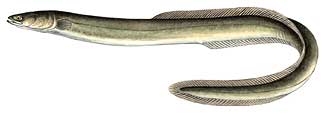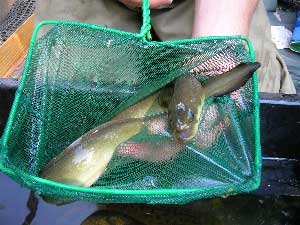American Eel
Anguilla rostrata
 Distribution: The American eel ranges from Greenland and Labrador south to northern South America and west to the Mississippi Valley. Eels will ascend any accessible coastal river and were once found throughout New Hampshire. Their current distribution is limited by dams.
Distribution: The American eel ranges from Greenland and Labrador south to northern South America and west to the Mississippi Valley. Eels will ascend any accessible coastal river and were once found throughout New Hampshire. Their current distribution is limited by dams.
Description: A long, slender, snake-like fish with thick, slimy skin, a small mouth, and tiny scales. The dorsal, caudal, and anal fins are fused into one continuous fin that runs the length of the eel’s body and wraps around the tail. Juvenile eels may be distinguished from lampreys by the presence of pelvic fins and a true jaw. American eels are usually dark brown to olive green on the back and grayish white below.
Species commonly confused with: Sea lamprey, American brook lamprey
Habitat: American eels may be found in almost any freshwater habitat that can be accessed from the ocean, although they reach their largest sizes and abundance in lakes, ponds, and larger rivers.
Life History:The American eel is the only catadromous species in New Hampshire waters. Adult eels migrate from freshwater rivers throughout the Atlantic coast to their spawning grounds in the Sargasso Sea. American eel larvae drift on ocean currents back to the coast line, where they migrate up rivers as juvenile eels, known as elvers. Juvenile eels have the ability to ascend obstacles that block other fish species. They can work their way through cracks in dams and climb vertical surfaces with only a trickle of water. However, dams and other barriers have greatly reduced the distribution of eels, which were once present in nearly all freshwater habitats that could be reached from the ocean. Eels may remain in freshwater for over 20 years before migrating back to the ocean. As adult eels prepare for their journey to the Sargasso Sea, their bodies undergo a transformation into what is known as the silver eel phase. Migration usually begins during the first significant rains of midsummer and continues into late fall. Silver eels do not eat as their bodies prepare for the transition into salt water. Female eels tend to migrate greater distances than males, which usually remain in estuarine habitat until sexual maturation. Hydropower turbines are a major cause of mortality as adult eels migrate downstream.
Origin: Native

Conservation/Management: Although American eels are relatively common in the coastal rivers of New Hampshire, they inhabit just a fraction of their historical range in the state. There is a significant drop in eel abundance upstream of the first major dams on the Merrimack and Connecticut Rivers. Upstream eel passage projects are underway at a number of hydroelectric dams in New Hampshire. Providing upstream passage for eels is relatively easy compared to downstream passage. The long slender body type of eels makes them particularly vulnerable to being chopped up by the propellers of hydroelectric turbines. Biologists are working with hydroelectric project owners to study downstream eel migration and provide recommendations that will improve downstream passage for adult eels.
American eels are harvested commercially as bait for recreational fisheries. Although eels are not commonly eaten in the United States, they are considered a delicacy in Japan. Elver fisheries are illegal in all states except South Carolina and Maine, where prices can reach up to $2,000 a pound for elvers used as seed stock for aquaculture facilities in Asia. The commercial harvest of eels is regulated by the Atlantic States Marine Fisheries Commission.



